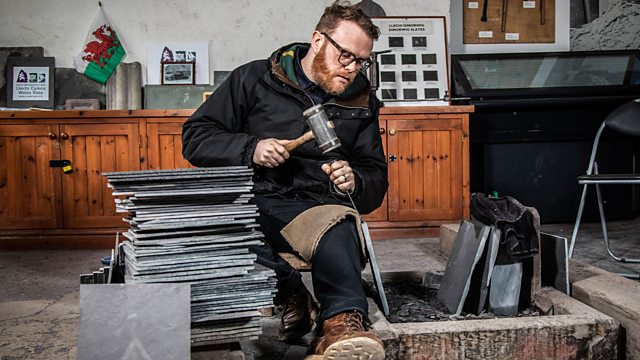
The Story of Slate
Huw Stephens learns about the history of the Welsh slate industry at the National Slate Museum in Llanberis.
Huw Stephens tells the story of the Welsh slate industry with a visit to the National Slate Museum in Llanberis. It’s an extraordinary story of ruthless landlords exploiting whole mountains to make vast profits from what is now Snowdonia National Park.
Quarrying slate was a brutal business, and working conditions for the poorly paid men were extremely dangerous. In 1900, the longest industrial dispute in British history started with the Great Penrhyn Strike at the quarry in Bethesda – the biggest quarry in the world at the time. But despite the hardships and environmental damage to the landscape that can still be seen to this day, the slate industry created a unique culture of poetry, music and song in the Welsh language.
The National Slate Museum is housed within the old Gilfach Ddu workshops at Llanberis, a site that once provided all the tools and maintenance for the huge Dinorwig quarry just above the village. The whole museum is a living artefact. It looks and feels as if the workers have just downed tools and left for the day.
Huw meets Andrew ‘JonJo’, a sixth-generation quarryman who himself worked for 32 years at the Penrhyn quarry in Bethesda. Now he is a demonstrator, showing visitors the fine craft of slate splitting. He explains why, despite life as a quarryman being tough, he is proud of his heritage and how there was real camaraderie among the men. At its height in the late 19th century, the Welsh slate industry employed 14,000 men and produced nearly half a million tons of slate per year. Welsh slate was exported across the British Empire and beyond, and is still considered some of the best in the world.
Elen Roberts, head of the museum, shows Huw some of the industrial artefacts. The huge waterwheel, the biggest in mainland Britain, used water from Afon Hwch that flows off Eryri (Snowdon) just up the valley to power the workshops. They were almost self-sufficient, manufacturing everything you would need for the profitable extraction of slate, from wagons and railway sleepers to hammers and chisels.
Elen shows Huw the impressive foundry where complex metal components were cast from molten iron. And in the loft, Huw sees the thousands of wooden patterns that were carved by hand to create the moulds into which the iron was poured. Elen explains that all of this priceless heritage would have been lost were it not for the actions of the quarry’s former chief engineer Huw Richards Jones, who stopped the ‘vultures’ circling and started a campaign to preserve the workshops and the artefacts.
One of the museum’s most poignant exhibits is Fron Haul, a row of traditional terraced cottages that were moved stone by stone from nearby Tan Y Grisiau and rebuilt at Gilfach Ddu. The houses have been furnished to represent life at three different quarries at three different times: 1861, the height of the industry, at Tan Y Grisiau, Blaenau Ffestiniog; 1969, Llanberis, the year the Dinorwig quarry closed; and 1901, Bethesda, the middle of the Great Penrhyn Quarry Strike.
The museum’s chief curator, Cadi Iolen, shows Huw around the 1901 house explaining the significance of the sign in the window that reads ‘Nid oes bradwr yn y ty hwn’, which translates as ‘There is no traitor in this house’. During the strike, quarrymen would put these signs in the window to show that they were still out. The strike lasted three long years and tore the community apart. Inside, Cadi shows Huw a conch shell that strikers’ wives would blow like a trumpet to shame the strikebreakers as they returned from work. And upstairs in a tiny bedroom, Huw finds a suitcase with a luggage label for Tumble, a sign that the man of the house was leaving to look for work in the south Wales coalfields.
Life was hard for the quarrymen of north Wales, but the communities that grew up around the industry were resilient too and created a unique culture. At the heart of this was Y Caban, or The Cabin, a kind of hut out on the quarry face where the men would gather to eat their lunch, drink tea and discuss the important matters of the day. These meeting places have come to take on an almost mythical status in the culture of the quarry, turning into centres of learning and political debate where working men could find respite from the hardship of their working life.
Lowri Ifor, the museum’s education officer, shows Huw the Caban at the Gilfach Ddu Workshops, complete with an eisteddfod chair awarded to the best poet at a quarry eisteddfod in 1938. Although the slate industry left a legacy of environmental destruction and economic hardship, it also created a unique Welsh-speaking culture in the industrial villages in the mountains that nurtured writers, poets and politicians as well as brass bands and male voice choirs that still thrive to this day.
The slate landscapes of Gwynedd, and the culture they created, have been designated a Unesco World Heritage Site, putting them on a par with the Taj Mahal and the Great Pyramids.
Last on
More episodes
Previous
You are at the first episode
Music Played
-
![]()
Luke Richards
Last Man On Earth
Credits
| Role | Contributor |
|---|---|
| Presenter | Huw Stephens |
| Interviewed Guest | Elen Roberts |
| Interviewed Guest | Lowri Ifor |
| Interviewed Guest | Cadi Iolen |
| Interviewed Guest | Andrew 'JohnJo' Jones |
| Production Manager | Gwyddfid Jones |
| Editor | Aled Meredith |
| Executive Producer | Llion Iwan |
| Producer | Siwan Haf |
| Director | Steve Robinson |
Broadcasts
- Mon 4 Apr 2022 19:30
- Tue 5 Apr 2022 02:00
- Mon 15 Aug 2022 19:00Â鶹ԼÅÄ One Wales & Wales HD only

